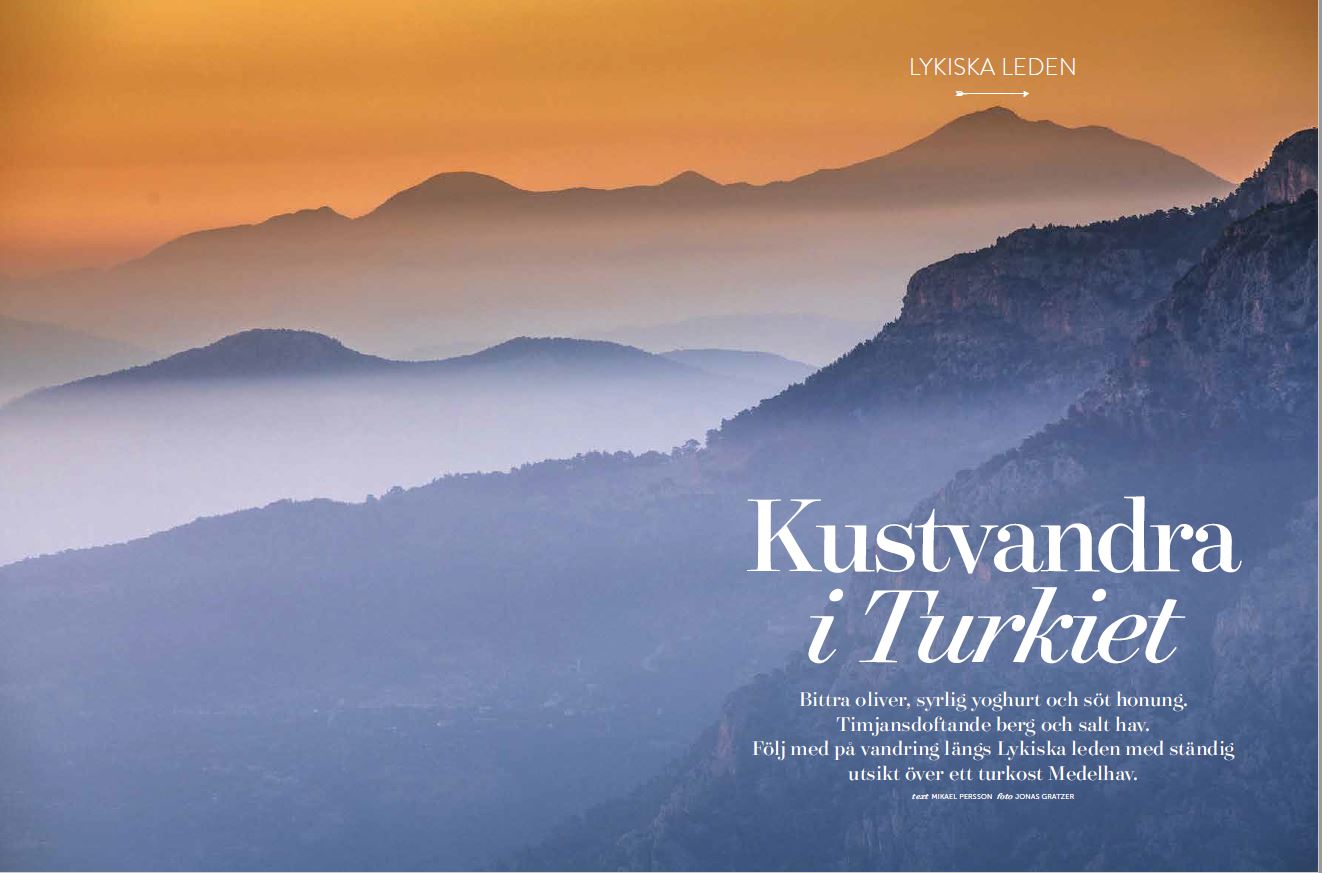
Author: Mikael Persson Photo: Jonas Gratzer
Our profile on Facebook is https://www.facebook.com/vagabond.se/
Below is a nice piece about the Lycian Way in a Swedish magazine. The English text is at the end of the page!
The Lycian Way
Definitely the smell of smoke! whispers my nostrils.
Absolutely life! answers my brain puzzled.
Together with Kate Clow and Berhat Onat Alan from the turkish trekking organization Culture Routes Society I have been walking the Lycian trail further and further away from towns and city noise. We climbed hills to the smell of thyme. Sleept under thick guesthouse blankets as the starry sky lit the Anatolian night. Reached beaches with turquoise mediterranean water. Enjoyed marvelous turkish cuisine and fresh fruit. And now this: In the middle of a several thousand years old higgledy-piggledy of tempel stones and sarcophagus awaits a very much allive rural village with cattle and freshly baked bread. A village that just preapared itself for the most important struggle since the days of Homeros Ulysses. The threat from mining.
How I got the idea?
Kate Clow eats slowly her gözleme pancake with filling of white cheese and fresh spinach. At the same time she is telling me how the idea about a epic trekking trail along the turkish south coast took shape. Same 20 years back she had just finnished her work with a World Bank project in Istanbul. In stead of moving back to Thatchers England, she choosed Antalya and a project that put Turkey in to one of the leading trekking destinations of the world.
Tourism was allready a huge thing in the area. But a lot of visitors asked me if there where any trekking possibilites. I realized a proper trekking trail could help to spread the money from tourism to the mountains and rural villages, and also being a useful tool to prevent nature and historical sites from being exploited.
Its this actual trekk we just started to walk. Kates and Onats visit to the area is one of many to check wheter the trail markings and signs are ok. But also to meet guesthouse owners and other people living along the trail to discuss new ideas and ensure everyone is asware of the importance of sustainability and quality.
Our first break is at Senol and Selma Bayazits Kirme Gözleme Evi & Lemon Café. Even tough the café is not more than a fireplace and some tables under a huge walnut tree, the business is a important and appreciated extra income for the family.
In nearby Fethiye there are huge hotels in company of sun chair beaches and loud techno. Here, on the other side of Baba Dag, it is a completly different world with goats and chickens running arround with a background of sharp mountains and ancient history.
Some 2000 years back, the coast inbetween todays Antalya and Fethiye was the birthplace for what is sometimes mentioned as the first democracy in the world. The 23 cities of the Lycian federation minted their own coins, was successfull in long distance trade and developed a advanced network of roads and trails.
Traces from that time still follows the coast together with remains from roman and byzantine time. Places of cult hiding among pine woods and strawberry trees. Ancient theatres, sarcophagus and temple columns along olive grooves. Rock tombs cut straight in to steep mountain sides. Bays and shores followed by old harbours where the ships used to sail to Egypt on the other side of the sea.
There are thousands of historical sites in the area. Quite a few of them had never been investigated by archeologists or got any protection. By attaching the mosaic to a trekking trail, the visitors could experience this exiting heritage, but also, indirectly, help to protect it, explains Kate when we are sitting on the Bayazit family veranda, sipping on refreshing ayran.
Mathematics are quite simple. The economy of Turkey is dependent upon tourism. Places and areas that are important to the buisness, are less likely to be detroyed or exploited than places that has no visitors or eyewitness at all.
Our break in Kirme lasts longer than expected. Also this is typical for the Lycian trail. Our hostess Selma is offering us tea and mullberries. Her husband Senol gives us generous spoons of his thick mountain honey. At the same time Kate tells me how she managed to realize her turkish trekking plan, despite not being so much in to outdoor activities back home in UK besides off road motorbiking tours to the country side. In stead her keen interest in history and archeology was essential to realize the project.
In order to find the ancient trails, you have to think as the people who was allive then. Soldiers used ridges for their trails, since they needed a good overview over potential dangers and enemies. When shepherds created their trails, they took more priority in access to water and shadow for their cattle.
During six years Kate walked from village to village to collect information and talk to shepherds and local farmers. 1999 the Lycian trail was opened. Since then the trekk has got a lot of international attention and being praised by the Times as one of the ten best walks of the world.
Today the Lycian trail is about 540 kilometers long. To accomplish the whole trekk takes more than 30 days. Some people grab the challenge. But the majority do as we do. Opt for some days or a week or two along the coast. Highlights are plenty. Nature, beaches and history is surley like candy for the soul. Cosy guesthouses and marvellous turkish home cooking gives an extra pleasant flavour to the walk compared to other long distance trekks of the world.
Early evening at Georges guesthouse in Faralya. During the gentle descent from Kirme we got used to our boots and trekking sandals in the company of olive grooves and siesta resting turtles. Down at the coast, the setting sun is slowly putting a orange blanket over a landscape challenging both eyes and minds.
Some walkers have settled with wine glasses. Others relax in hammocks. A university teacher from Eskisehir discuss with a female yoga instructor from Istanbul which trails to follow tomorrow.
The view is exactly the same for everyone. A half a kilometre or so right below us, the steep cliffs of Butterfly valley hits the bottom before it guides the canyon towards its entrance along the sea. At the same time red fire flies are dancing on the sky in front of me. Just across the sea comes glimpses from the city lights of Fethiye.
Our second day of trekking. Got awake to the smell of wild herbs. Absolutely thyme. Maybe myrtle and marjoram aswell. The sunrise just opened up 360 degress of adrenalin. At our back, goats are grazing on a hoplessly steep slope along costal cliffs. In the front, the spurs of the Toros mountains is disappearing nortwards together with birds of prey in slowly circles.
The landscape speak allmost the same language as in the storys of the gods of antiquity. Still its both vulnerable and under constant threat. Some generations back allmost everyone in Faralya was surviving on very small means from bee keeping, grapes, olives and goats. Now the incomes from trekking tourism is helping the village to keep allive and preventing people from giving up their lives at the countryside and move to costal cities. At the same time the balance is delicat not to risk any harm in nature and environment.
What can we do to attract visitors to stay in our village longer than just one night, asks gueshouse owners Recep Karadag and Farder Baskani during a breakfast meeting with Kate.
Both are keen on developing income possibilities in Faralaya, without risking the soul of the village. Donkey safaris for familys with children is one suggestion. Luggage transfer arranged by local taxi drivers is another. All ideas are appreciated by Recep and Farder who ends the meeting with a clear statement.
We are on the right track! But our village shall never be as Kabak!
Early afternoon we are there, in Kabak. We have been walking through dense pine forests and then followed thistles down to the coast and straggly banana plants. The beach is a beach to dream about. At one side, sharp mountains building natural fortressess. At the other side, the sea changing from cobalt to turquoise. In a few minutes I am swimming lazily among the gentle ripples of salty water.
Somebody had made plans for building a hotel or a holiday village, but everything was stopped by the authorities before anything happend, reacalls Kate from her fist visit in Kabak some 20 years ago.
At that time, the place was green and quiet and most visitors arrived by foot. Now new possibilities have been opened up with a asphalted road for cars and buses. In just a decade or so Kabak changed in to something newage chiqt attracting young peole from Istanbul, reminding me of some sort of turkish Woodstock in swimming suit and bikini.
At every visit I discover a new bar or a new guesthouse. A lot of the newly built is illegal. Even tough the land is protected, authorities are keeping a blind eye and are happy to just ask for a fine, because a fine is more lucrative than tearing down the black buildings, explains Kate.
High above Kabak, the small hamlet of Alinca is located right at the edges of the clouds. My own sleep is with that certain ease and comfort you allways get at places with fresh mountain air.
Once again we are back to a slow and gentle country pace. Everything is just perfect. A family owned guesthouse reminding me of a ordinary turkish home. Warm blankets. Night sky full of stars. And a quiet morning.
Our hostess have just set a outdoor table with our breakfast. Freshly made bazlama. Honey with walnuts. Pickled pumpkin, sallads, yoghurt and börek filled with white cheese. At the same time our view goes all the way down to the sea. And I get the impression I can see everywhere. Even back in time.
A few moments later we are walking along the Lycian trail on a old mule path, kaldirim. Some 50 years back the brittish authoress Freya Stark travelled through the south of Turkey and remarked Lycia was one of few places where yesterdays landscape is connected to todays landscape.
Get exactly that feeling when we climbed a small hill and have Sidyma below us. In 1842 the place was rediscovered by the german archeologist
Augustus Schönborn who ventured out from Fethiye to look for the ship wich was supposed to bring him to Rhodes. In stead he got lost among the cliffs and the thorns and found the lycian ruins of Sidyma intermingled with a turkish hamlet.
His sight should be about the same as what I got now. I follow Onat between huge sarcophagus and 2000 years old pillars. Behind a collapsed theatre we are also apporached by the sound of present life: cackling geese, peoples voices and the muezzin. At one of the low stone houses are our lunch is awaiting.
How I ended up here?
Brea Pelletier smiles. Every stranger entering her house is probably asking the same question. Born in Canada. Father working at a turkish road costruction site. Then, on a visit to him, she saw a photo that changed her live and brought her permanent to the other side of the Atlantic.
As soon as I saw the picture, I realized that this was the place where I belonged, says Brea.
Two years later she travelled to Sidyma to ask the village leader, mukthar,
if it was possibly to buy some land or a house. His answer was yes. And now she speaks belongs to the community in a turkish village build upon layer of layer of old history. In one of the neighbouring houses the living room is followed by an old roman mosaic. Just outside there is also a 600 years old and hollow olive tree.
Sidyma still lives its life as allways on smale scale farming, goats and honey. But several of the families also earns some extra incomes by offering food and lodging to trekkers arriving along the Lycian way. Brea and her friend Fatma have just made the table with lunch: köfte, yoghurt sallad, pickled radish, olives and pomegranate sauce.
We eat the home cooked food slowly and listen to how the village just been challanged by a turkish company who plan to open up a marble quarry.
Everyone is against it. Our archeological herritage will be threated. Beekepers and farmers are affraid of dust and pollutions ruining their livelyhood. Besides all that, the Lycian trail needs to be redirected to a new route, which means Sidyma will loose valuable incomes, says Brea who got help from Kate and Culture Routes Societys to try the case in court.
The process is complicated. The company keep changing their application in order to prolonge everything and to split the village by giving economic promisses to certain key persons. Even tough, their are good hopes for Sidyma to win the battle.
Our lawyer have managed to stop the access roads to the quarry. So if they want the get out the marble, they need a helicopter. And that would be very expensive, says Brea.
The afternoon sun has slowed down the speed. Or is it all the food ive been eating in Sidyma? Anyhow, finally we reach the village of Gey at the last threshold of the Taurus mountains. Veils of moist air rises from the sea and puts parts of the cliffs under a white shroud. In one of the houses, a little bit further inland, awaits the former village leader Bayram, by local authorities called Efe Bayram, Bayram the bandit, after refusing giving a permit to chop down forest in the area.
Why should I do that? The animals and the birds lives there and the roots of the trees helps to stabilise the ground and prevent the land from being harmed by landslides.
Bayram has reached the age of 63. The heavy moustasch and his hair has turned white, but the body still looks strong and muscular, as a witness of his early days when he went up before sunset to work at the tobacco fileds or walked to Faralya to participate in wrestling games.
The area has allways been isolated and affected by water shortage. Especially the young ones gives up farming and leaves the village. At 2004 the local school closed down.
For my family, the Lycian way becme a turning point, says Bayram.
His house opend up for trekkers. The first guests slept on the roof. After a while Bayram built an extra room and then another one until he created a guesthouse. The buisness created a income that made the impossible possible.
Two of my daughters have studied at university. And my youngest daughter nowadays take care of the guesthouse. I am a happy man now, says Bayram the bandit while sipping his morning coffe.
Last day along the Lycian trail. As usal our breakfast table is loaded with goodies. Freshly baked bread. Plates and bowls with tahini, yoghurt and olives. Pots of tea and plates of menemem.
Starts to walk in the early morning. Eyes focused on the red and white trail markings. Soon I am transformed in to the liberated vacuum called trekking. No space in my head for mobil phones or checking emails. Just nature and the present moment. Start to observe the small details. Flowers attracted by brownie butterflies. The black and white spikes who belonged to a night walking porcupine. The overgrown terraces and square cut stones whispering about ancient settlement or a castle.
Late afternoon we reach our goal. Just beyond ancient Pydnai awaits the longest sand beach in Turkey. Kilometre after kilometre of golden grain follows the waves towards Patara and the place where Apollon had his winter reside and Sankt Nicolaus was born in 280 ad. At the same time a glowing sun is setting slowly over Anatolian mountains with all its layer by layer of distant history. Hopefully this unique mix of ancient memories and todays days people will still be here as bridge between past and present. In many ways thanks to the Lycian trail.
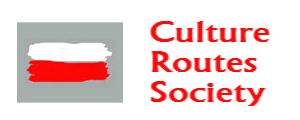
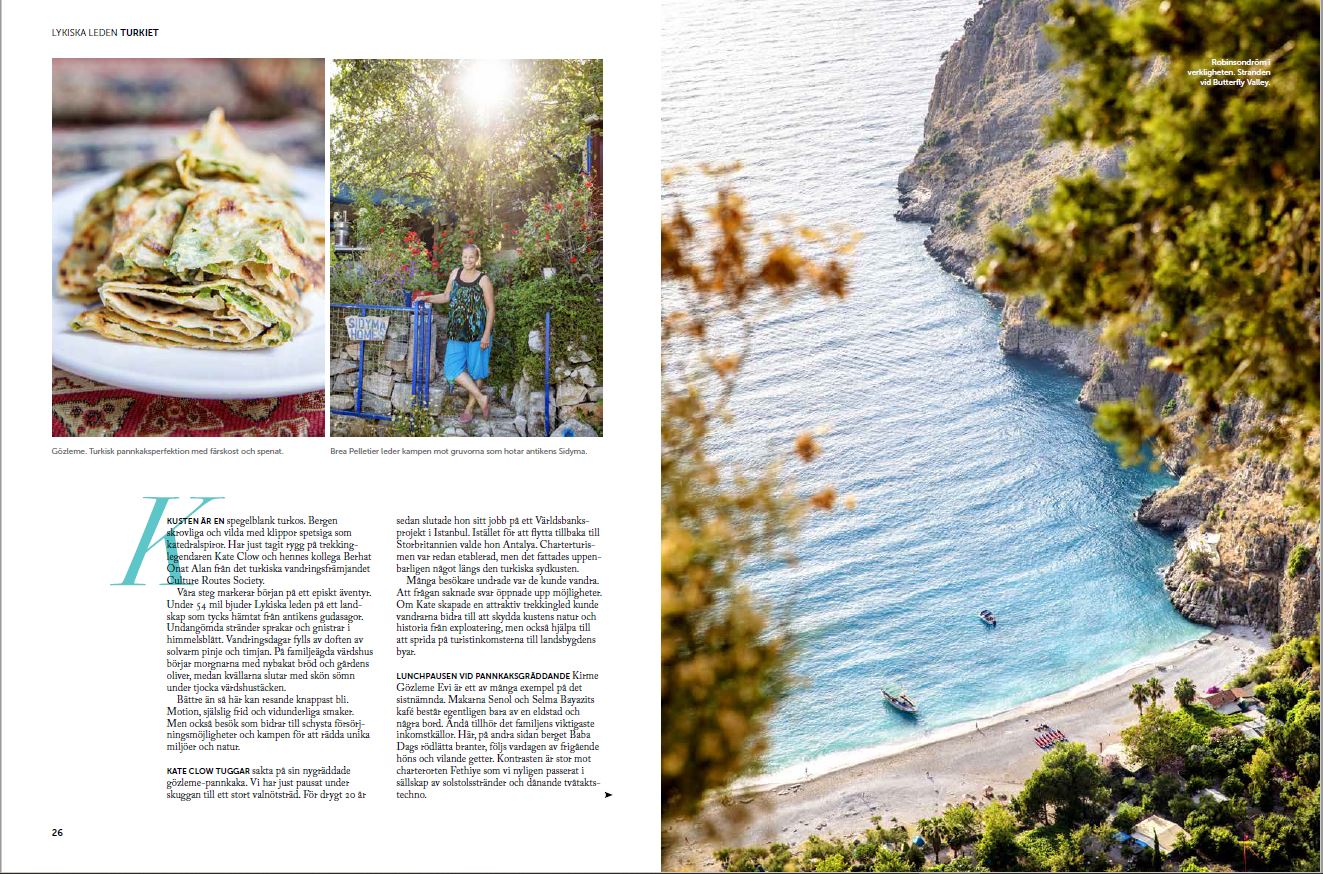
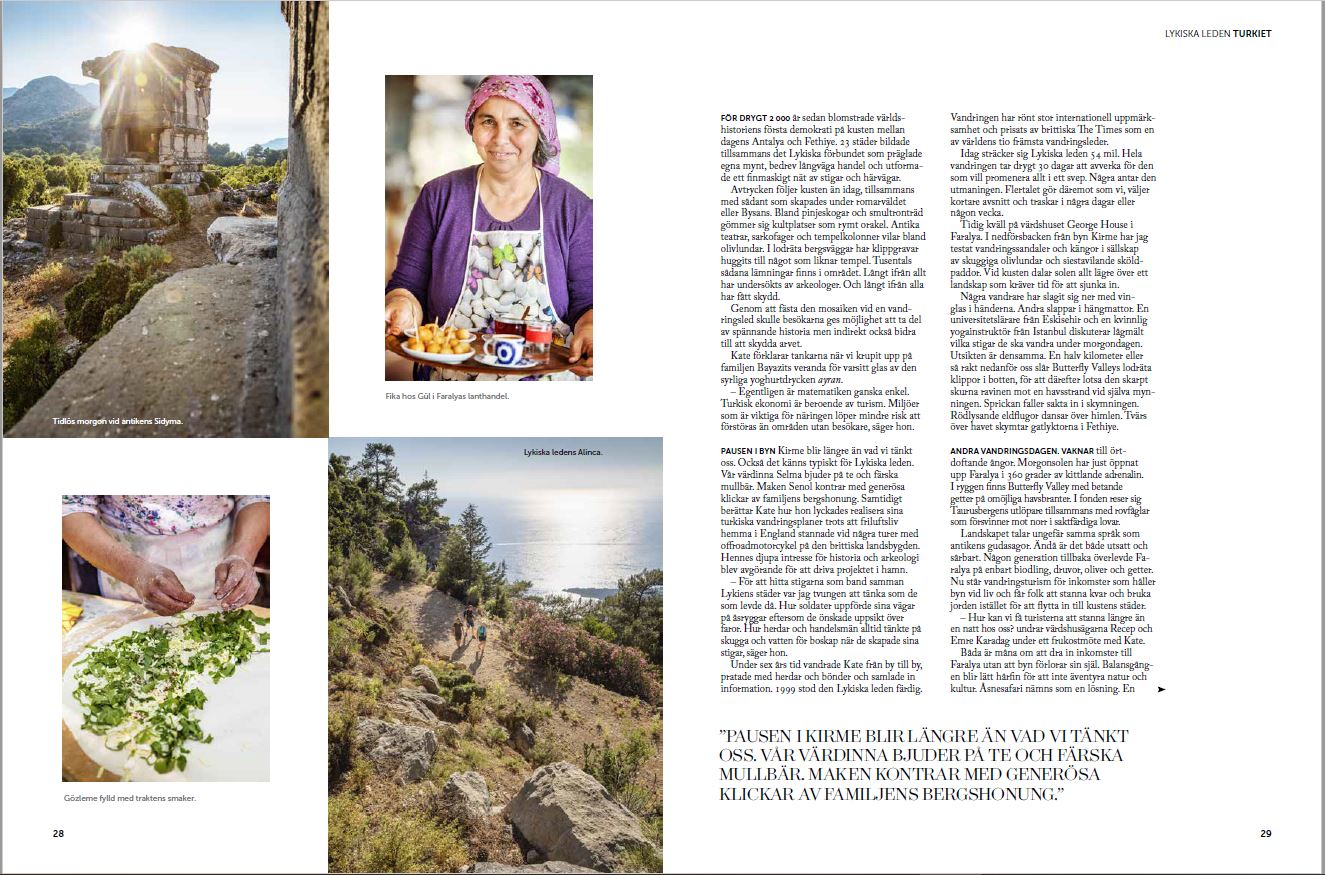
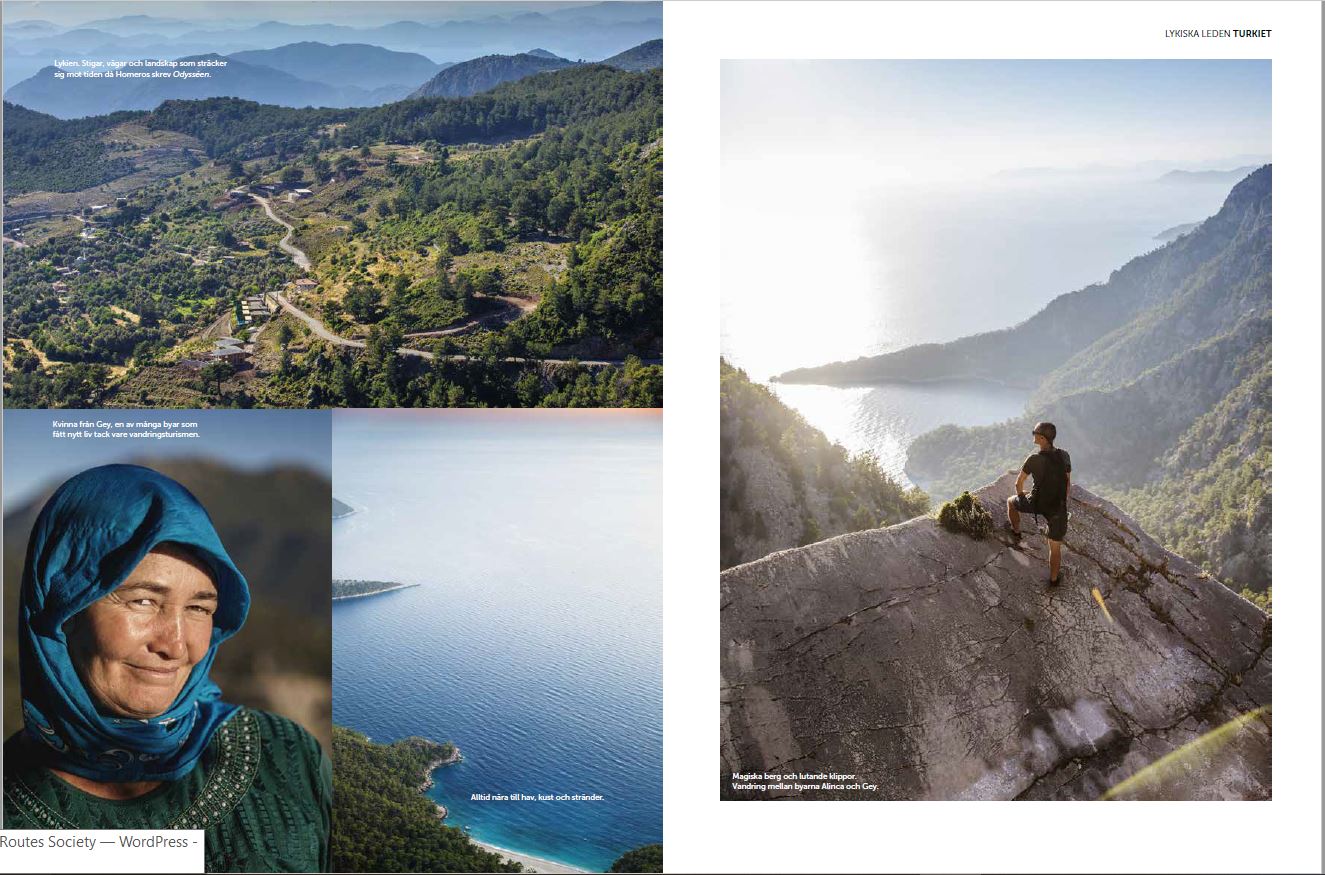

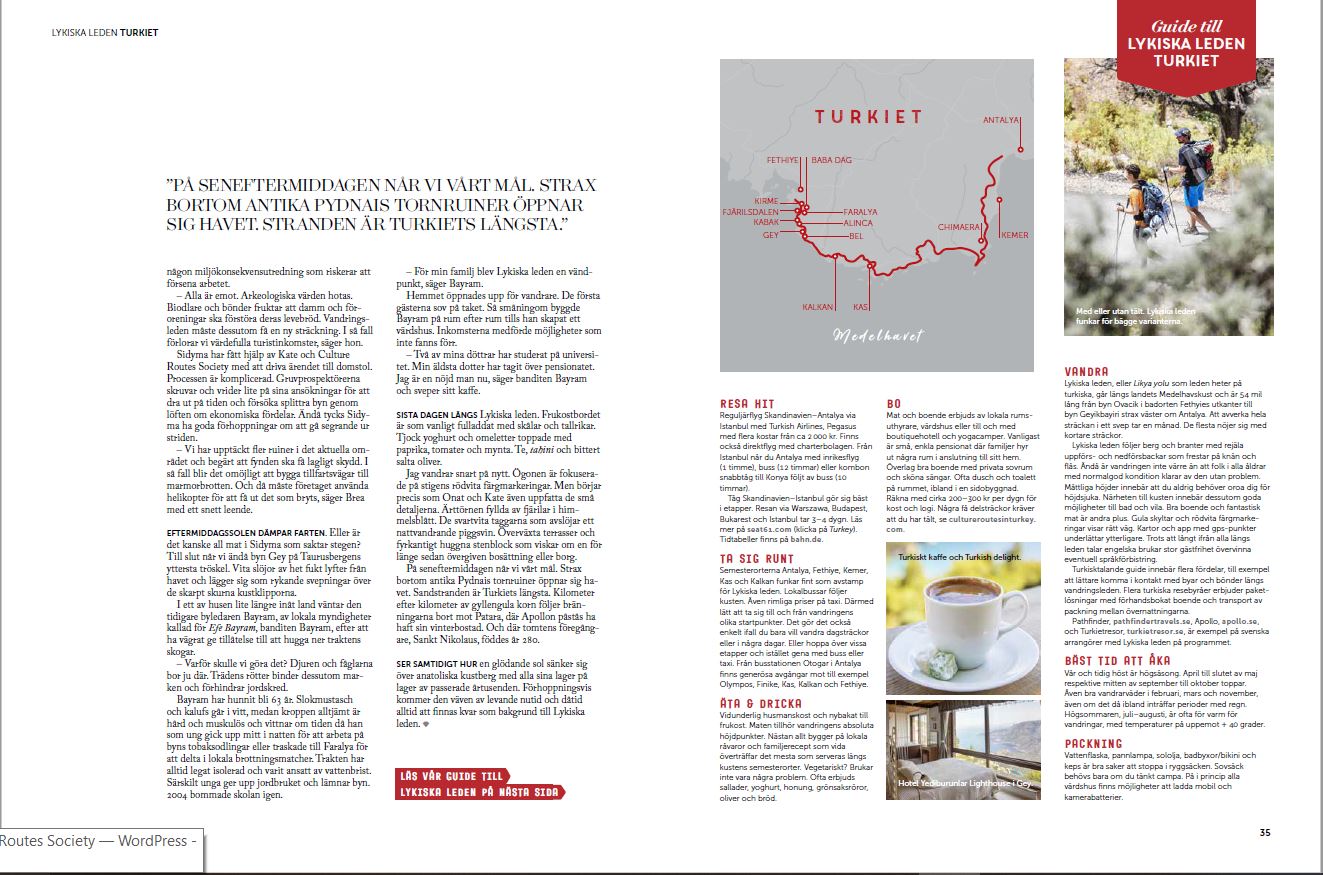
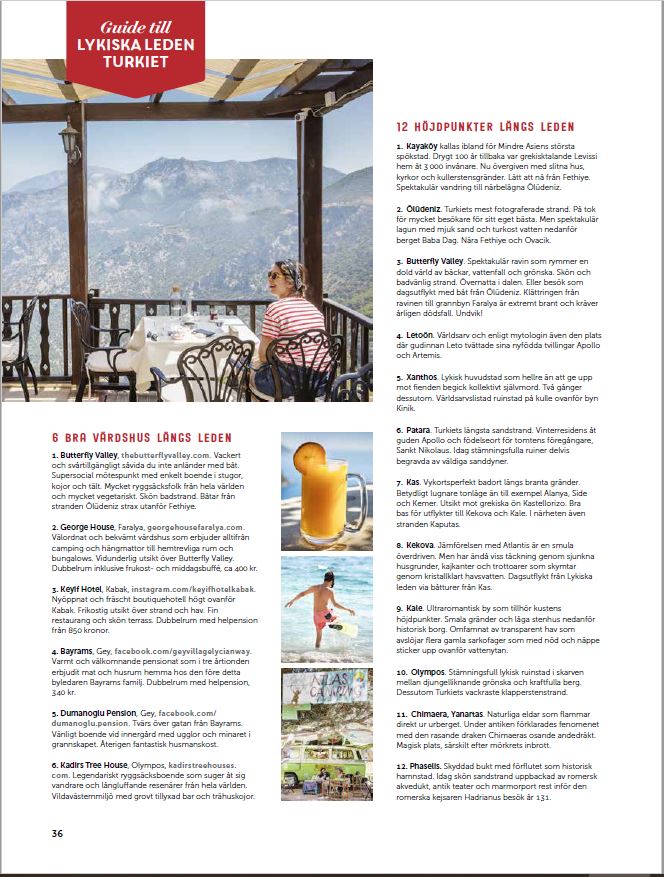

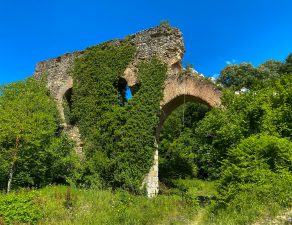
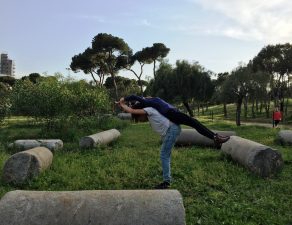

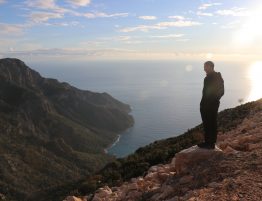


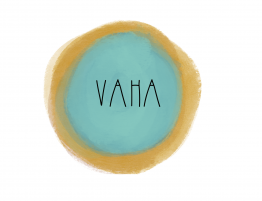
Write a comment: